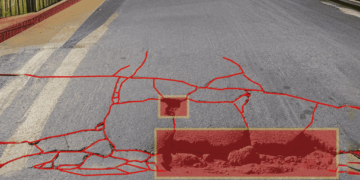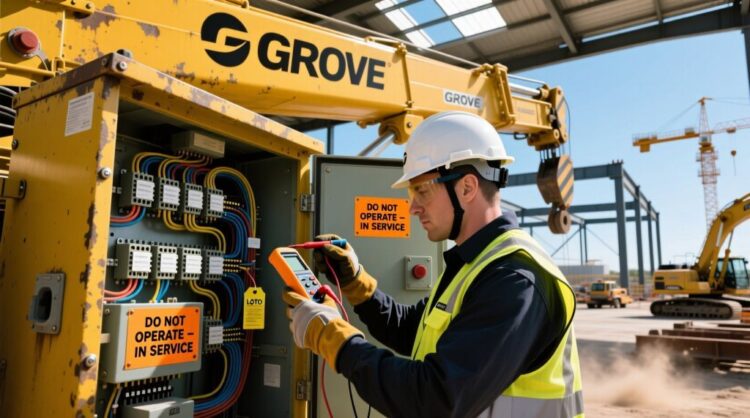Electrical faults can bring Grove crane operations to a halt, but a structured approach can resolve most issues efficiently. This guide is designed for operators, maintenance technicians, fleet supervisors, and service managers who need to diagnose and fix electrical problems. By prioritizing safety, working methodically, and using quality parts, you can minimize downtime and keep your crane running reliably.
Safety: The First Rule
Before starting any troubleshooting, isolate all power sources and apply lockout/tagout procedures. Batteries, capacitors, and control modules can retain hazardous charges, even when the crane is powered off. Wear insulated gloves and safety goggles to protect yourself. If live testing is necessary, use one hand to reduce the risk of shock and avoid contact with moving components like booms, winches, or sheaves.
Start with the Fundamentals
Many electrical issues stem from simple problems. Dead batteries, loose ground connections, or blown fuses are common culprits behind crane downtime. Begin by testing battery voltage—a 12V system should read approximately 12.6V at rest, while a 24V system requires checking both banks separately. Clean corroded terminals with a wire brush, tighten all connections, and retest under load to confirm battery performance.
Visual Inspection: Spot the Obvious
A thorough visual inspection can reveal issues before you dive into complex diagnostics. Check wiring harnesses and connectors for:
- Chafed, frayed, or pinched wires
- Burned or melted insulation
- Corroded or loose connectors
- Moisture or debris in junction boxes
Focus on high-movement areas, such as near the boom, winch, or sheaves, where wires are prone to wear. Replace damaged components with high-quality Grove crane parts sourced from a reputable crane parts supplier. Avoid temporary fixes like taping exposed wires, as they often lead to recurring failures.
Fuses and Relays: Quick Checks First
Blown fuses indicate an overload or short circuit. Inspect the fuse panel and replace any blown fuse with one of the correct amperage rating. If the replacement fuse blows again, you’re dealing with a deeper fault. Relays can also fail, causing intermittent issues like erratic crane functions or alarms. Swap a suspect relay with a known good one of the same type, documenting its position to avoid confusion during reassembly.
Connectors and Grounds: Critical Connections
Intermittent electrical faults often trace back to faulty connectors. Look for corrosion, loose pins, or water ingress in connectors. Clean them with electrical contact cleaner and apply dielectric grease to prevent future corrosion. If connectors are damaged beyond repair, replace them with parts from a trusted crane parts supplier to ensure compatibility with Grove crane parts.
Ground connections are essential for stable operation. A weak ground can cause unpredictable symptoms, such as flickering displays, delayed controls, or false alarms. Clean chassis ground points with sandpaper or a wire brush and secure them with star washers or new hardware to ensure a solid connection.
Multimeter: Your Diagnostic Ally
A multimeter provides precise diagnostics, eliminating guesswork. If a component like a solenoid, swing motor, or hydraulic pump fails to operate, test for voltage at the device during operation. No voltage suggests an issue upstream, such as a blown fuse or faulty relay. If voltage is present but the component doesn’t function, the fault lies within the component itself. Test continuity with the circuit powered off to identify shorts or open circuits quickly.
Operator Controls: Wear and Tear Issues
Joysticks, switches, and pedals endure heavy use, making them prone to failure. Worn contacts or failing potentiometers can mimic major electrical issues, causing inconsistent operation. Use a multimeter to check each control’s signal output for stability. If readings are erratic, replace the control rather than attempting repeated cleanings. Source replacements from a crane parts supplier specializing in Grove crane parts to ensure proper fit and function.
CAN Bus and Fault Codes: Modern Challenges
Modern Grove cranes rely on CAN bus systems to connect control modules. When a fault code appears, record it immediately—it’s a critical clue to the problem’s source. Check CAN bus wiring and termination resistors for continuity or damage. A system reboot may clear temporary glitches, but persistent codes indicate deeper electrical or software issues that may require a Grove-trained technician.
Sensors: The Crane’s Feedback Loop
Sensors monitor critical parameters like load, pressure, angle, or position, feeding essential data to the control system. A faulty sensor can trigger shutdowns or provide false readings, disrupting operations. Verify each sensor’s supply voltage and signal output against manufacturer specifications. Replace any sensor with inconsistent or out-of-range readings, using genuine Grove crane parts from a reliable crane parts supplier for long-term reliability.
Motors, Solenoids, and Contactors: Heavy-Duty Diagnostics
Large components like motors, solenoids, and contactors can fail without obvious signs. Test motor insulation resistance with a megohmmeter—low readings indicate moisture or winding damage. Inspect contactors for pitted surfaces or burned coils and replace them if compromised. Solenoids that hum but fail to actuate may have jammed plungers or failed windings. Swap with a known good unit to confirm the fault before ordering replacements.
Heat: A Warning Sign
Overheating components are a red flag. Use an infrared thermometer to check for hot spots in cables, connectors, or junction boxes during operation. Hot spots often result from high resistance due to loose or corroded connections. Tighten or replace these parts immediately to prevent further damage or potential fire hazards.
Document Every Step
Keep detailed records of all troubleshooting steps: voltages, fault codes, observations, and repairs. Photograph damaged components, including their serial numbers and model details. This documentation is invaluable when ordering from a crane parts supplier, ensuring you receive the correct Grove crane parts quickly and without errors.
Sourcing Quality Parts
When replacing components, choose a reputable crane parts supplier. Generic or low-cost parts may fit but often lack the durability and precision of genuine Grove crane parts. For complex components like wiring harnesses or control modules, replacing the entire unit is often more efficient than repairing individual wires. Always provide the crane’s serial number to ensure an exact match.
Know When to Seek Help
Some issues, such as electronic control unit (ECU) failures, firmware glitches, or complex CAN bus problems, require specialized expertise. If basic troubleshooting doesn’t resolve the fault, contact a factory-trained Grove technician to avoid costly mistakes or prolonged downtime.
Prevent Issues with Maintenance
Proactive maintenance prevents electrical faults. Seal connectors to block moisture, protect harnesses in high-wear areas, and apply dielectric grease in wet environments. Keep battery compartments clean and well-vented to avoid corrosion. Schedule and log regular electrical inspections to catch potential issues before they escalate.
Final Verification
After completing repairs, test all crane functions without load, then under controlled load conditions. Monitor for unusual noises, overheating, or new fault codes. Run a diagnostic scan to confirm the system is clear of errors. Document the results to verify the repair’s success.
Troubleshooting Grove crane electrical issues requires patience, precision, and a logical approach. Start with simple checks, trace the current path, and replace only what’s confirmed faulty. Partner with a trusted crane parts supplier for Grove crane parts to ensure long-term reliability. This method keeps your crane operational, your crew safe, and your projects on schedule.



















